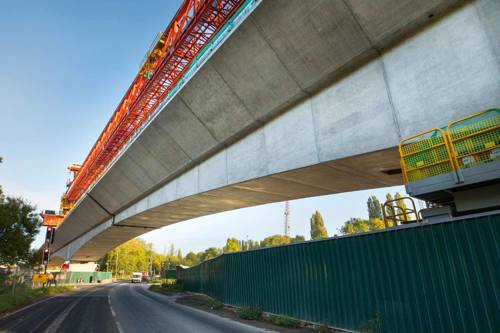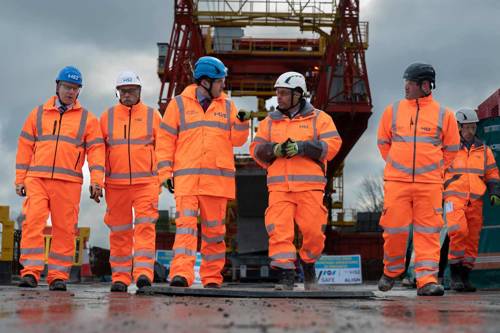 Known as a ‘launching girder’, the 160m long bridge-building machine is the only one of its kind operating in the UK and is used to lift the giant concrete deck segments that form the viaduct’s arches into position. Once each section is complete, the machine inches itself forward to build the next stage.
Known as a ‘launching girder’, the 160m long bridge-building machine is the only one of its kind operating in the UK and is used to lift the giant concrete deck segments that form the viaduct’s arches into position. Once each section is complete, the machine inches itself forward to build the next stage.
The first 141 - out of a thousand - deck segments are now in position, with each one weighing up to 140 tonnes. To allow for the gentle curves of the viaduct as it crosses the valley, all the segments are slightly different shapes and made on site at a purpose-built temporary factory close to the north abutment.
Welcoming the milestone, HS2 Ltd Project Client David Emms said: “After seven months of hard work, it’s great to finally be able to walk on part of the Colne Valley Viaduct. Once complete, this record-breaking structure will form a key part of the HS2 route – helping to deliver better connections across the UK, free up rail capacity on the existing train network, and offer passengers zero carbon travel options.
“I’d like to thank all those involved in getting us to this exciting stage and look forward to seeing the whole viaduct come together over the coming years.”
 The huge viaduct project is being led by HS2’s main works contractor Align JV – a team made up of Bouygues Travaux Publics, Sir Robert McAlpine and VolkerFitzpatrick.
The huge viaduct project is being led by HS2’s main works contractor Align JV – a team made up of Bouygues Travaux Publics, Sir Robert McAlpine and VolkerFitzpatrick.
Originally built in 2004, the launching girder was first used during the construction of the Hong Kong East Tsing Yi Viaduct. Specially designed to handle complex viaduct construction, the machine is named ‘Dominique’ in memory of Bouygues engineer Dominique Droniou who played a leading role in its design and development.
Align Project Director, Daniel Altier, said: “The team at Align, along with supply-chain partners VSL, Kilnbridge, KVJV, VolkerStevin, Tarmac, Sendin and Vaughan Plant Haulage, have worked incredibly hard to get us to this point. They have demonstrated exceptional teamwork and expertise and I’m incredibly proud of what they have achieved so far. In particular, the successful completion of the A412 crossing which involved collaboration with multiple stakeholders to minimise disruption to our local community.”
56 piers each weighing around 370 tonnes are being constructed along the Colne Valley ahead of the girder, with the machine moving from one pier to the next, installing the deck segments as it goes.
Segments are placed alternately on each side of the pier, using a cantilever approach to balance the structure, as two half-arches are constructed simultaneously. Steel tensioning cables are then threaded through the segments to strengthen the bridge.






